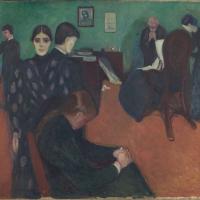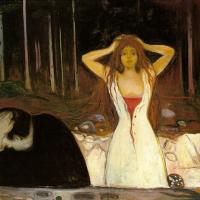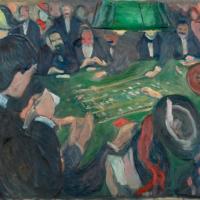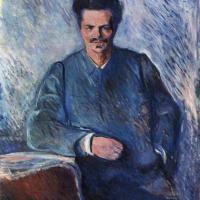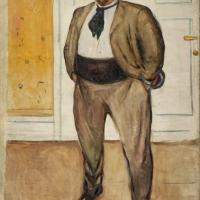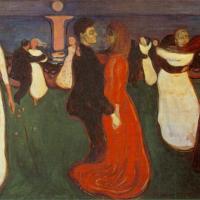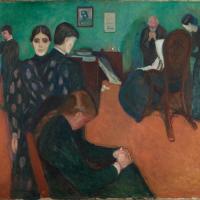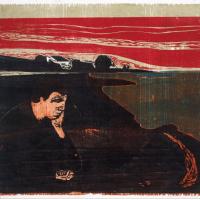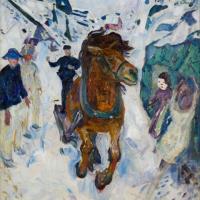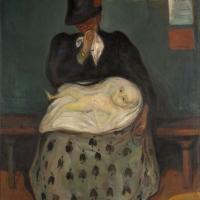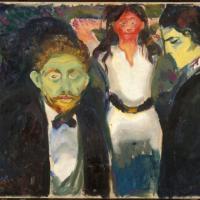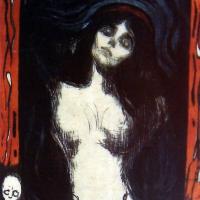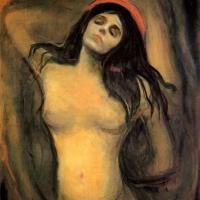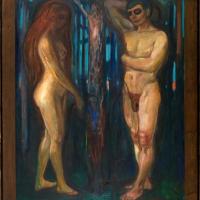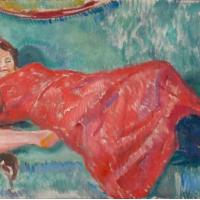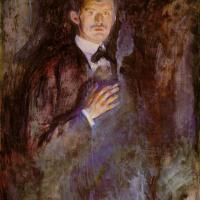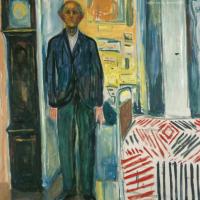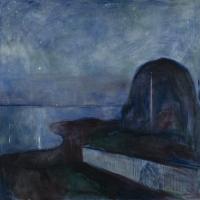Edvard Munch
A Portrait Of Grief
$450.00
Anxiety
$450.00
Ashes
$450.00
August Strindberg
$450.00
Consul Christen Sandberg
$450.00
Dance Of Life
$450.00
Death In The Sickroom
$450.00
Evening. Melancholy I
$450.00
Four Girls In Arsgardstrand
$450.00
Galloping Horse
$450.00
Inheritance
$450.00
Jealousy
$450.00
Madona
$450.00
Metabolism
$450.00
On The Sofa
$450.00
Red And White
$450.00
Rowboats At Asgardstrand
$450.00
Separation
$450.00
Shore With Red House
$450.00
Starry Night
$450.00
Edvard Munch
Edvard Munch (1863-1944)
Edvard Munch (12 December 1863 – 23 January 1944) was a Norwegian painter, whose best known work, The Scream, has become one of the most iconic images of world art.
His childhood was overshadowed by illness, bereavement and the dread of inheriting a mental condition that ran in the family. Studying at the Royal School of Art and Design in Kristiania (today’s Oslo), Munch began to live the bohemian life, under the largely negative influence of the nihilist Hans Jæger, who did, however, urge him to paint his own emotional and psychological state (‘soul painting’). From this would presently emerge his distinctive style.
Travel brought new influences and new outlets. In Paris, he learned much from Paul Gauguin, Vincent van Gogh and Henri de Toulouse-Lautrec, especially their use of colour. In Berlin, he met Swedish dramatist August Strindberg, whom he painted, as he embarked on his major canon The Frieze of Life, depicting a series of deeply-felt themes such as love, anxiety, jealousy and betrayal, steeped in atmosphere.
But it was back in Kristiania that his legendary work The Scream was conceived. According to Munch, he was out walking at sunset, when he ‘heard the enormous, infinite scream of nature’. That agonised face is widely identified with the angst of modern man. Between 1893 and 1910, he made two painted versions and two in pastels, as well as a number of prints. One of the pastels would eventually command the fourth highest nominal price paid for a painting at auction.
As his fame and wealth grew, his emotional state remained as insecure as ever. He briefly considered marriage, but could not commit himself. A breakdown in 1908 forced him to give up heavy drinking, and he was cheered by his increasing acceptance by the people of Kristiania and exposure in the city’s museums. His later years were spent working in peace and privacy. Although his works were banned in Nazi Germany, most of them survived World War II, ensuring him a secure legacy.
The Scream is Munch's most famous work, and one of the most recognizable paintings in all art. It has been widely interpreted as representing the universal anxiety of modern man. Painted with broad bands of garish color and highly simplified forms, and employing a high viewpoint, it reduces the agonized figure to a garbed skull in the throes of an emotional crisis. With this painting, Munch met his stated goal of "the study of the soul, that is to say the study of my own self".
To the end of his life, Munch continued to paint unsparing self-portraits, adding to his self-searching cycle of his life and his unflinching series of takes on his emotional and physical states. In the 1930s and 1940s, the Nazis labeled Munch's work "degenerate art" (along with that of Picasso, Klee, Matisse, Gauguin and many other modern artists) and removed his 82 works from German museums. Adolf Hitler announced in 1937, "For all we care, those prehistoric Stone Age culture barbarians and art-stutterers can return to the caves of their ancestors and there can apply their primitive international scratching."
In 1940, the Germans invaded Norway and the Nazi party took over the government. Munch was 76 years old. With nearly an entire collection of his art in the second floor of his house, Munch lived in fear of a Nazi confiscation. Seventy-one of the paintings previously taken by the Nazis had been returned to Norway through purchase by collectors (the other eleven were never recovered), including The Scream and The Sick Child, and they too were hidden from the Nazis.
Munch died in his house at Ekely near Oslo on 23 January 1944, about a month after his 80th birthday. His Nazi-orchestrated funeral suggested to Norwegians that he was a Nazi sympathizer, a kind of appropriation of the independent artist. The city of Oslo bought the Ekely estate from Munch's heirs in 1946; his house was demolished in May 1960.
When Munch died, his remaining works were bequeathed to the city of Oslo, which built the Munch Museum at Tøyen (it opened in 1963). The museum holds a collection of approximately 1,100 paintings, 4,500 drawings, and 18,000 prints, the broadest collection of his works in the world. The Munch Museum serves as Munch's official estate, and has been active in responding to copyright infringements, as well as clearing copyright for the work, such as the appearance of Munch's The Scream in a 2006 M&M's advertising campaign. The U.S. copyright representative for the Munch Museum and the Estate of Edvard Munch is the Artists Rights Society.
One version of The Scream was stolen from the National Gallery in 1994. In 2004, another version of The Scream, along with one of Madonna, was stolen from the Munch Museum in a daring daylight robbery. All were eventually recovered, but the paintings stolen in the 2004 robbery were extensively damaged. They have been meticulously restored and are on display again. Three Munch works were stolen from the Hotel Refsnes Gods in 2005; they were shortly recovered, although one of the works was damaged during the robbery.
In October 2006, the color woodcut Two people. The lonely (To mennesker. De ensomme) set a new record for his prints when it was sold at an auction in Oslo for 8.1 million kroner (US$1.27 million). It also set a record for the highest price paid in auction in Norway. On 3 November 2008, the painting Vampire set a new record for his paintings when it was sold for US$38,162,000 at Sotheby's New York.
Munch's image appears on the Norwegian 1,000-kroner note, along with pictures inspired by his artwork.
In February 2012, a major Munch exhibition, Edvard Munch. The Modern Eye, opened at the Schirn Kunsthalle Frankfurt; the exhibition was opened by Mette-Marit, Crown Princess of Norway.
In May 2012, The Scream sold for US$119.9 million, and is the second most expensive artwork ever sold at an open auction. (It was surpassed in November 2013 by Three Studies of Lucian Freud, which sold for US$142.4 million).
In 2013, four of Munch's paintings were depicted in a series of stamps by the Norwegian postal service, to commemorate in 2014 the 150th anniversary of his birth.
On 14 November 2016 a version of Munch's The Girls on the Bridge sold for US$54.5 million at Sotheby's, New York, making it the second highest price achieved for one of his paintings.
In April 2019, the British Museum will host a new exhibition, Edvard Munch: Love and Angst, which will comprise 83 artworks and include a rare original print of The Scream.


